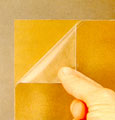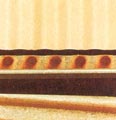Tools & Resources
FAQs
Your search for Guttering returned 43 results.
 What is the price difference between the standard, Ultra and Metallic ranges of COLORBOND® steel?
What is the price difference between the standard, Ultra and Metallic ranges of COLORBOND® steel?
Prices will vary depending upon the manufacturer you choose. Bluescope Steel makes COLORBOND® steel as flat sheet rolled into coils. It's our rollformer customers who turn this 'raw' material into the various profiles and products you're familiar with. Please use our Find a Supplier to find a rollformer in your area who will be able to help you with information on pricing of their products.
 Where can I buy your product?
Where can I buy your product?
You can find your closest suppliers using our Find a Supplier.
 What is the price of COLORBOND® steel? Can you give me a quote for my house or project?
What is the price of COLORBOND® steel? Can you give me a quote for my house or project?
Prices will vary depending on the manufacturer you choose. Bluescope Steel makes COLORBOND® steel as flat sheet rolled into coils. It's our rollformer customers who turn this 'raw' material into the various profiles and products you're familiar with. Please use our Find a Supplier to find a rollformer in your area who will be able to help you with information on pricing of their products.
 Where can I get a sample of your colours?
Where can I get a sample of your colours?
You can order colour samples on our Brochure and Swatches page, or Find a Supplier.
 Why can't I find any profiles, dimensions, spans on your site?
Why can't I find any profiles, dimensions, spans on your site?
While Bluescope Steel makes COLORBOND® steel, it's our rollforming customers who turn it into the various steel products you're familiar with, such as roof cladding, guttering and fencing panels. There are many rollformers out there, each supplying different products with different product specifications. You can Find a Supplier in your area who will be able to help you with the types of profiles they have available and other product information.
 My gutters have a plastic film on them. What is it and how can I remove this?
My gutters have a plastic film on them. What is it and how can I remove this?
Many products made from COLORBOND® steel eg gutters, fascias, downpipes, are supplied with a specially designed polyethylene film called CORSTRIP® strippable film.
This film protects the sheet during storage and handling and should be stripped off immediately on installation.
The film is easily removable on installation and is plastics (4) recyclable. Check with your local council to find out whether plastics (4) can be recycled via regular kerbside pickup or through your local waste management depot.
Sunlight can increase the adhesion of this film so it is vital that sheets are not left uncovered outside. Coil product that has CORSTRIP® strippable film applied should be processed within 12 months to minimise possibility of increased adhesion.
If the film cannot be removed successfully it has cross linked with the paint system and there is no recommended method to remove it without affecting the paint. The item should be replaced with new product.
This information is intended as a guide only. For detailed assistance with your particular application, please contact us.
 What sealants (silicone) can I use with COLORBOND® steel?
What sealants (silicone) can I use with COLORBOND® steel?
Neutral Cure silicone rubber sealants are the only sealants recommended for use with COLORBOND® steel and ZINCALUME® steel. Look for the words "Neutral Cure" on the sealant cartridge to make sure. View our page: Select a sealant for the job.
 Can I use galvanised gutters?
Can I use galvanised gutters?
The phenomenon of inert catchment has caused the demise of many gutters made from galvanized steel. Roofing which does not change the quality, nature or rainwater as it flows across the roof is referred to as inert catchment.
This may be COLORBOND® steel, terracotta tiles, sealed concrete tiles, acrylic sheeting, glass, ZINCALUME® steel, or aluminium. This means that rainwater with any chlorides or acids dissolved in it from the atmosphere flows into the gutter. Inert roofing material does little to change the chemical nature of this water which can be detrimental to galvanised gutters (which are non-inert).
While galvanised gutters provided excellent service as catchments for old fashioned roofing materials such as unglazed tiles and galvanised steel, it is not recommended as a catchment for modern, inert roofing products.
We recommend gutters and rainwater products made from COLORBOND® steel or ZINCALUME® steel as these will provide equal service to that of the roofing material.
BlueScope Steel No Longer Recommends the Use of Galvanised Gutters and Downpipes.
This information is intended as a guide only. For further information, please Download Technical Bulletin TB 15 - Selection and use of steel eave gutter, downpipe and fascia products.
 Can I use lead flashings with my roof made from COLORBOND® steel?
Can I use lead flashings with my roof made from COLORBOND® steel?
Lead is not compatible with ZINCALUME® steel or COLORBOND® steel. ZINCALUME® steel or COLORBOND® steel is also prone to corrosion when in contact with or receiving run off water from lead.
Instead of lead, the recommended flashing materials that can be formed on site are soft zinc or aluminium.
Popular flashing materials include COLORBOND® steel or ZINCALUME® steel sheet formed to suit the application. While zinc-coated steel can be used with ZINCALUME® steel or COLORBOND® steel, its generally lesser life span makes it impractical in the long term.
When using COLORBOND® Stainless steel we recommend the use of stainless steel flashing products. Flashings made from zinc coated, zinc/aluminium alloy coated and COLORBOND® prepainted steel should not be used with COLORBOND® Stainless steel.
Roof penetration flashings are also available in a wide range of rubber and aluminium materials, and these are commonly used.
In the event of roof renewals where lead flashing already exists and its re-use is desirable, the ZINCALUME® steel or COLORBOND® steel should be insulated from the lead by a suitable barrier. This can be achieved by painting the underside of the lead. Plastic film can also be used to separate the surfaces, provided it is robust enough and will not tear, eg Polyethylene damp-course.
Painting the underside of lead flashings already existing on an old building well enough to ensure separation is not easy. Polyethylene damp-course placed between the lead and ZINCALUME® steel or COLORBOND® steel sheet is a better alternative.
Lead in the water run-off can be avoided by painting the top surface of the lead flashing. Applying two or three coats of water-based acrylic is suitable but any painting should be maintained so that it will not break down and expose any of the lead surface.
This information is intended as a guide only. For further information, please Download Technical Bulletin TB 8 - Selection and use of steel eave gutter, downpipe and fascia products
 What fasteners should I use with COLORBOND® steel?
What fasteners should I use with COLORBOND® steel?
Please view our page Choose fasteners for cladding.



